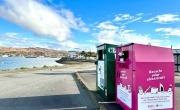Sellafield clean-up costs taxpayers £1.5bn a year

The cost of decommissioning the Sellafield nuclear waste site in Cumbria has already reached £67.5 billion and shows ‘no indication’ of slowing down, a new government report reveals.
The Public Accounts Committee (PAC), appointed by the House of Commons to examine ‘the appropriation of the sums granted to Parliament’ and ensure they ‘meet the public expenditure’, released the Nuclear Decommissioning Authority: Managing risk at Sellafield report today (4 February), criticising the spiralling financial cost of decommissioning the nuclear waste site.
According to the report, successive governments have been ‘guilty of failing to tackle issues on the site’, and have ‘allowed an enormous nuclear legacy to build up’.
The report also lambasts the management of the site (run by Sellafield Limited on behalf of the Nuclear Decommissioning Authority), saying that ‘basic project management failings’ have caused increased costs and delays, with ‘only two of the 14 major projects… delivered on or ahead of schedule in 2011-12’.
It reads: ‘Over several decades, successive governments have been guilty of failing to tackle issues on the site, allowing an enormous nuclear legacy to build up. Deadlines for cleaning up Sellafield have been missed, while total lifetime costs for decommissioning the site continue to rise each year and now stand at £67.5 billion.
‘The Authority believes it now has a credible plan for decommissioning Sellafield and expects Sellafield Limited to start retrieving hazardous waste currently held in legacy facilities in 2015. Nonetheless, given the track record on the site… we are not yet convinced that this date will be met or that sufficient progress is being made.
‘It is essential that the Authority brings a real sense of urgency to its oversight of Sellafield so that the timetable for reducing risks does not slip further and costs do not continue to escalate year on year.’
Decommissioning costs public ‘£1.6 billion a year’
 Rt Hon Margaret Hodge MP, Chair of the PAC, further criticised the handling of the decommissioning, claiming “there’s no indication of when [the decommissioning] cost will stop rising”.
Rt Hon Margaret Hodge MP, Chair of the PAC, further criticised the handling of the decommissioning, claiming “there’s no indication of when [the decommissioning] cost will stop rising”.
She continued: “It is unclear how long it will take to deal with hazardous radioactive waste at Sellafield or how much it will cost the taxpayer. Of the 14 current major projects, 12 were behind schedule in the last year and five of those were over budget.”
The PAC report goes on to question the ‘robustness’ of the clean-up plan and whether the Nuclear Decommissioning Authority (NDA) is ‘progressing the development of the geological disposal facility as quickly as possible’.
Just last week, plans to build an underground nuclear waste disposal facility in Cumbria were quashed, after the county council decided to withdraw from the process, leaving government without a potential voluntary UK site.
Hodge added: “[N]ow that Cumbria County Council has ruled out West Cumbria as the site of the proposed geological disposal facility, a solution to the problem of long-term storage of the waste is as far away as ever.
“Taxpayers will have to foot the bill. Private contractors who gain contracts take no risk because of the uncertainties that persist… All payments… need to be strictly controlled and determined by the value gained, so that payments are not made where companies have not delivered.
“Public money to the tune of £1.6 billion is being spent at Sellafield each year. This is an area of considerable deprivation with high unemployment. We are looking for there to be clearer ambition that spending on this huge scale contributes to creating jobs and supports sustainable growth in the region and the UK."
‘We need to do better’
 Reacting to the report, Chief Exectutive of the NDA, John Clarke said: “Prior to the NDA's inception [in 2005] there was no credible lifetime plan for Sellafield and tough decisions about how we ultimately decommission the site had simply been put off for future generations to deal with.
Reacting to the report, Chief Exectutive of the NDA, John Clarke said: “Prior to the NDA's inception [in 2005] there was no credible lifetime plan for Sellafield and tough decisions about how we ultimately decommission the site had simply been put off for future generations to deal with.
“We are now facing up to those challenges and for the first time we have a proper plan in place for the decommissioning of Sellafield which lays out in detail programmes of work for every area of the site.”
Adding that there are a ‘significant number’ of existing facilities that ‘meet the highest international standards’ for storing high and intermediate level waste, Clarke went on to outline that future plans for the site include an “ongoing construction programme of surface stores” that will be built over the next 10 to 15 years to a value of around £600 million.
Clarke continued: “The report has focused on the major projects element of the Sellafield programme which represents some £450 million a year out of Sellafield's £1.6 billion annual site expenditure. It has recognised the progress made by the NDA in developing the strategy and plans to tackle this hazardous legacy, as well as the difficult context of putting in place a contract to deliver a programme of work whilst significant uncertainty about the scope of the task remains. Of course, not everything has gone smoothly on such a complex and highly technical programme and the report has rightly pointed to areas where we and the site need to do better.
“We have a programme of improvements in place and continue to work with Sellafield Ltd and NMP to make continued progress across a broad front of safe operations and project delivery.”
Management of the Sellafield site has been criticised at length recently, with a report released by the National Audit Office in November 2012 condemning the existing storage of nuclear waste at the Sellafield site as ‘outdated’ and finding that some radioactive waste facilities had ‘deteriorated so much that their contents pose significant risks to people and the environment’.
Indeed, problems with the site clean-up have been long-running, with the NDA contracting an international consortium – Nuclear Management Partners Limited – in November 2008 to improve Sellafield Limited’s management of the site.
Read the PAC's Nuclear Decommissioning Authority: Managing risk at Sellafield report.
Read more about the legacy of nuclear waste.






